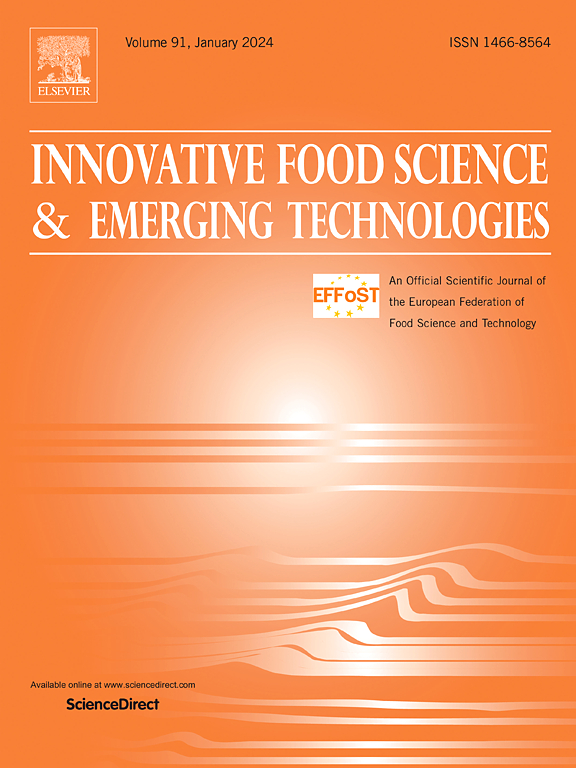螺旋藻生物质作为蛋白质替代品在喷雾干粉中的评价:从初始悬浮液到粉末特性
IF 6.8
1区 农林科学
Q1 FOOD SCIENCE & TECHNOLOGY
Innovative Food Science & Emerging Technologies
Pub Date : 2025-06-11
DOI:10.1016/j.ifset.2025.104084
引用次数: 0
摘要
正确的喷雾干燥操作是生产最佳藻植物蛋白粉的关键。因此,本研究探讨了螺旋藻生物量与单独的豌豆蛋白和混合的豌豆蛋白作为潜在的牛奶类似物,以及与脱脂牛奶在实验室规模喷雾干燥生产速溶粉过程中的行为。特别地,对不同配方的初始液体进料的粒度分布、流变行为和物理稳定性进行了表征,并强调了它们对所生产粉末的物理和最终使用性能的影响。结果表明,含螺旋藻的饲料具有剪切减薄的特性,具有很高的粘度,有利于悬浮液的物理稳定性。添加豌豆蛋白对降低饲料粘度有显著效果。在选定的条件下,获得了满意的工艺得率(>;50%)和水活度(<;0.2)。由于其粒径较小(<16 μm),粉末具有粘性,流动性较差,但与脱脂牛奶和单独的豌豆蛋白相比,以螺旋藻为基础的粉末效果更好。螺旋藻粉很容易复水化,具有很好的润湿性,但由于雾化过程中的高剪切作用和干燥过程中的高温作用,导致初始悬浮粒度分布没有完全恢复,这也影响了粉末的颜色。从粉末和工艺的角度来看,螺旋藻生物量和豌豆蛋白是制造替代乳模拟粉的有希望的候选物,但感官和功能方面还需进一步考虑。本文章由计算机程序翻译,如有差异,请以英文原文为准。
Evaluation of Spirulina biomass as a protein alternative in spray dried powders: From initial suspension to powder properties
Proper operation of spray drying is essential to produce optimal algae-plant protein powder. Therefore, this study explores the behavior of Spirulina biomass compared to pea protein alone and in mixture, as potential milk analogues, in comparison with skim milk during spray drying at laboratory scale to produce instant powder. In particular, the particle size distribution, the rheological behavior and the physical stability of the initial liquid feed for the different formulations were characterized and their influence on the physical and end-use properties of the powders produced was highlighted. The results revealed that the feeds containing Spirulina had a shear-thinning behavior, with a very high viscosity that contributed to the physical stability of the suspension. The addition of pea protein was interesting to decrease the feed viscosity. In the chosen conditions, spray dried powders were obtained with a satisfying process yield (> 50 %) and water activity (< 0.2). Due to their small size (<16 μm), the powders were cohesive with a poor flowability, but compared to skim milk, and pea protein alone, it was better for Spirulina based powders. Powder rehydration was obtained readily, with a very good wettability of the powders with Spirulina but the initial suspended particle size distribution was not totally recovered probably due to some changes under high shear during atomization and high temperature during drying that also had an impact on the color of the powders. From the powder and process point of view Spirulina biomass and pea protein appear as promising candidates for creating alternative milk analog powders, but the sensory and functional aspects must be further considered.
求助全文
通过发布文献求助,成功后即可免费获取论文全文。
去求助
来源期刊
CiteScore
12.00
自引率
6.10%
发文量
259
审稿时长
25 days
期刊介绍:
Innovative Food Science and Emerging Technologies (IFSET) aims to provide the highest quality original contributions and few, mainly upon invitation, reviews on and highly innovative developments in food science and emerging food process technologies. The significance of the results either for the science community or for industrial R&D groups must be specified. Papers submitted must be of highest scientific quality and only those advancing current scientific knowledge and understanding or with technical relevance will be considered.

 求助内容:
求助内容: 应助结果提醒方式:
应助结果提醒方式:


